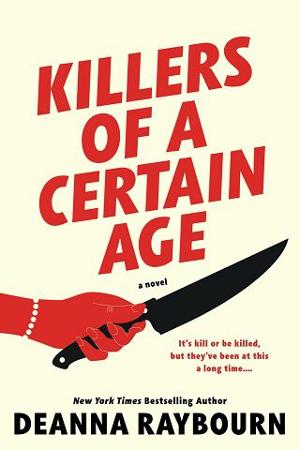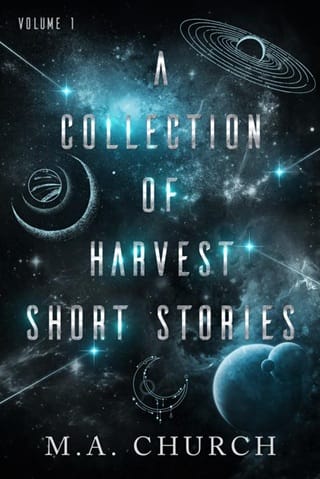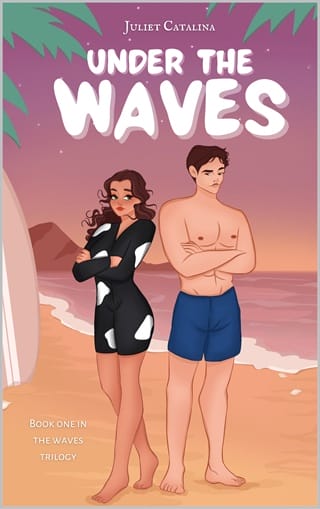Chapter Thirty-Three
CHAPTER THIRTY-THREE
Two down, one to go, I repeated to myself as I made tea. It drummed in my head, relentless as the rain that pounded down day after day. We’d only been back for three days, but England was getting on my nerves. To begin with, I was feeling every last second of my sixty years after the hit on Carapaz. Muscles I had forgotten about were stiff and sore, and my knuckles and knees were bruised to hell and back. Mary Alice had stitched up my shoulder—neatly, with tiny, precise stitches. But it itched like fire, and the more it itched, the crankier I got.
The fact that days were passing with no plan on how to find Vance Gilchrist was also a solid nuisance. We started to snipe at each other, but that didn’t help. Soon the house was filled with the sound of slamming doors and everybody’s spite music turned up to drown out the others. Natalie was blasting Lizzo from her phone over the Babymetal Minka played through her laptop. Helen unearthed a portable record player from the attic which still worked, and she even found a half-warped Carole King album to play on it. It couldn’t compete with Mary Alice’s Baroque opera on BBC Radio in the kitchen. Dido was just screeching her last when I tapped out, taking a pack of cigarettes and a notebook to the garden shed along with the folder we had lifted from Carapaz’s house. I stacked a few moldy bags of mulch to make a sort of sofa and sat, listening to CCR and smoking with my fingers going numb. If it had been summer, a curious rabbit or a friendly mouse might have kept me company, but there was nothing Beatrix Potter about that shed. It was drafty and damp, and the tip of my nose burned with the cold.
Whenever a hit was ordered, a packet would come with the preliminary information put together by Provenance. The packet always looked like something your great-aunt would send, a chatty letter on personalized stationery and a selection of newspaper and magazine clippings, recipe cards, knitting patterns. Every squad of Museum recruits had their own theme devised during training. All communication with us came on notepaper headed with an illustration of a young girl looking over a flock of sheep. It was a play on Constance’s code name of Shepherdess, and the letters were always signed “Aunt Constance” although the actual writing was done by some grunt in Provenance. We ignored the text of the letter and paid attention to the picture at the top. It varied subtly depending on the information it was supposed to convey. The number of sheep told us how many weeks until the hit needed to happen; the direction the shepherdess was facing, the color of the ribbon on her crook—all of them gave us another piece of the puzzle. And every page in the packet added more detail until we knew exactly who we were supposed to kill, complete with suggestions on locations, the subject’s patterns of behavior, personal interests, and obvious vulnerabilities.
Once the packet was decoded, it was up to us to devise the actual plan. We coordinated with Acquisitions for supplies and logistics of carrying it out, and a team from that department was always tasked with getting whatever we needed as well as monitoring for further developments. Initially, our plans had to be approved by the head of the Exhibitions department, but once we’d proven ourselves, we were left on our own to develop our plans, and I had a routine for mine.
The day a packet came, I cleared my schedule. I canceled appointments, rescheduled deadlines for my freelance translating work. Then I settled in with a pack of Eves and the silver lighter my mother had accidentally left behind the day she walked out. Next to the lighter and cigarettes, I would arrange a fresh notebook and a new Ticonderoga, sharpened to a needle point. Then I would pour a glass bottle of Big Red over ice and settle in. The ideas didn’t come until I had sat for a while, smoking and listening to the ice crack, the air smelling of burnt tobacco and the cotton candy tang of the soda. I turned the lighter over in my hand as I thought, wearing down the chunks of turquoise like worry beads.
After the first glass was half-drunk and a couple of butts had been ground into the Bakelite saucer I used for an ashtray, I’d start jotting ideas. Random words at first, questions, possibilities. I didn’t censor this part, just wrote whatever came to me. I would keep at it, smoking and writing and drinking until I had a headache from the Eves and a stomachache from the soda. And the plan would be there, rough, but with all the major parts working. It usually took several more days to finish it off, smoothing out the ragged ends and tucking them in until I had a neat little scheme. It had been my method for forty years and it had never failed me.
But now I didn’t have a Ticonderoga or a pack of Eves, and I sure as hell didn’t have any Big Red. I had a notebook from the pound store with a picture of a basket of puppies on it and a marker that smelled like bubble gum. And I had my lighter. I pulled it out of my pocket and lit one of the god-awful cigarettes left from the brew we’d made for Günther. It was cheap and rough and I coughed until my eyes streamed before stubbing it out on the sole of my boot. I rubbed my thumb over the lighter, noting every lump of turquoise, rubbed smooth from years of handling. It was heavy and not particularly pretty, and I was sure my mother had stolen it from one of the men she referred to as her “boyfriends.” There had been so many of them, all vaguely the same, with flashy cars and unsuspecting wives. She would take up with them for a weekend or a year, however long they managed to convince her that this time she’d met a good man who would really take care of her. She never saw the clues, or maybe she just didn’t want to. She would shake out her blond hair and put on another coat of frosted lipstick and get into yet another Camaro, thinking this time it would be different.
But it never was. She got older but never any smarter, and with age came desperation. She just wanted so badly to be loved, but the love of a child wasn’t enough, wasn’t the right kind of love. So I learned to keep it back, not to burden her with it. She loved me best when I didn’t ask anything of her, so I carried that love alone until the day she up and walked away for good. She left with a man, of course, this one heading for California. He had a paunch and a shirt open to his navel, but he drove a Cadillac and had a plan to make money. The fact that a kid was a dealbreaker didn’t stop her; it probably didn’t even slow her down. She took whatever she could carry that would pawn easily, which is how I know she forgot the lighter. It would have gotten her a few bucks for gas money or a Stuckey’s pecan log.
At first, I hoped she might send for me. I used that lighter on a birthday candle. I didn’t have a cake—Meemaw’s budget didn’t stretch that far and she hadn’t even remembered my birthday. But I found a broken candle from a faded box in the pantry and I lit it with my mother’s lighter, making the same wish I’d made when I’d stolen a rabbit’s foot keychain from the five-and-dime just so I could rub it.
The wish never came true. I used the lighter to burn the postcard she sent from Venice Beach telling me how wonderful it was but how she just couldn’t afford the bus ticket for me to visit. After that I stopped checking the mail and I stopped looking backwards. But I kept the lighter. I used it when I wanted to burn my bridges, torching report cards and disciplinary notes, rejection letters and pink slips. I glued back the turquoises when they fell out and refilled the fluid and kept it polished. I moved a lot during my first years with the Museum. I preferred furnished rentals and kept my possessions light—just a single box of things I could ship easily from place to place. Over the years, the things in the box changed, but the lighter was the constant, the one item I always carried in my pocket. I used it to burn intel and light signal fires and flaming shots when the occasion called for it. It lay on the nightstand the first time I spent the night with Taverner, and I used it to light a cigarette the last time I said good-bye to him, my hand shaking so badly I could hardly get it to catch. It was a talisman of sorts, and it never failed me.
Until now. I turned it over and over in my hand, but it just felt cold and heavy. There was no inspiration for how to find Vance, only the biting cold of the shed and the weight of the lump of silver in my hand. I flicked it, kindling the little flame. I passed my hand over it, warming it a bit but mostly killing time, bringing my palm closer and closer with each pass.
I flipped open the folder from Carapaz’s house and paged through it. Whatever instinct had prompted me to snatch it on the way out had paid off. It was our dossier, the one prepared for the board, alleging we were on the take. Like all material prepped for the board, it was almost clinical in its tone, laying out the evidence like a trail of bread crumbs for the directors to follow. There was a section on each of us, complete with murders we were supposed to have committed for pay. I skimmed my pages again, going over the lurid details. They were laughable—targets I had never even heard of, methods I rarely used. The whole thing smelled sloppy to me, like it had been assembled too fast or by somebody with no time to spare.
I lit another cigarette—it might have been nasty but I needed the nicotine—and blew out a mouthful of smoke slowly, making rings. Smoke and mirrors, that’s all the dossier was, a prop to keep on hand in case anybody asked questions about us. The file was the old-fashioned kind, pasteboard covers with a long metal bracket down one side. The arms of the bracket were threaded through holes punched in the pages inside, keeping everything neat and tidy, with little clasps to hold the bracket arms down and form a temporary binding. It meant the pages could be flipped through like a book, complete with a snug little gutter on the inside. I flicked the clasps off and straightened the bracket arms before I slid the front cover off. I pulled each page free until I saw it, a tiny set of coded characters running vertically along one of the inside margins. Every dossier came with a code like that, a series of letters and numbers that could be interpreted if you knew what you were looking at. Every person who had a hand in compiling it added their initials and the date to the code. By the time it got to a field agent, the code could take up the entire length of the page. This one was short—one set of initials and one date. One person had compiled the dossier.
I ran my finger over the initials, remembering my conversation with Naomi Ndiaye, searching for anything I might have missed. After a while, I put the dossier back together and clipped the cover into place. I had some answers, but there was only so much I could do without more information.
I pulled out the phone Minka had set up for me and dialed in Naomi’s number. There was a long moment of silence, then an automated voice.
“This number is no longer in service. If you believe you have reached this message in error, please hang up and dial again.”
I jabbed the “off” button and swore. The bitch had changed her number, no doubt to keep me from calling her again.
I figured it was a long shot, but I was running low of options. I punched in the number of the answering service I’d given Martin. When it picked up, I keyed in the pin, expecting to hear the usual snippy recording. “You have no new messages.” Instead, she perkily told me that I had a new message and asked if I’d like to hear it.
“Yes, you stupid bitch,” I muttered.
The recording didn’t like that. “I did not recognize that response,” she said, sounding offended as a recording can sound.
“Yes, please and thank you, with sugar on top and cream on Sundays,” I said.
“One moment, please.”
There was a long few seconds of staticky silence before Martin’s voice came through, sounding younger than I remembered and hushed, as if he were afraid of being overheard.
“Billie, it’s Martin. I think I heard something, or maybe I didn’t. I don’t know. But I had to bring some files to Vance and I went to the bathroom and when I came back, he was on the phone. He didn’t hear me, so I . . . shit, I eavesdropped, okay. I don’t know what it means, but he said the same phrase twice. Toll mash. I know it sounds stupid and I’m probably going to hate myself for even thinking it might help, but I feel bad. I mean, you were always nice to me, Billie. I—I have to go. Toll mash. I hope it helps.”
I pressed “end call” and stared at the phone, rolling the phrase over in my mind. Toll mash. I couldn’t even begin to imagine what it might mean. It sounded like a wrestling move or something to do with a chocolate chip cookie.
“Toll mash.” I tried saying it out loud and that didn’t help. I closed my eyes and pictured the letters, but they didn’t look right. Instead of toll mash, I kept picturing something different.
tollemache.
The name was vaguely familiar, but I couldn’t remember why. I clapped my hands together to get some warmth back into them, then plugged the word into the search bar of my phone. There were 775,000 results, but the first was what I wanted. Tollemache’s Auctions and Private Sales. Along with Christie’s and Sotheby’s, it was one of the big three auction houses in London, specializing in paintings and jewelry. I pulled up their website and the landing page featured an exquisite Boldini woman in pink satin and tulle. Tollemache’s was traditional, stuffy even. They’d sooner burn the house down than sell contemporary art. No stuffed taxidermy sharks or canvases streaked with menstrual blood for them. They were strictly old-school.
And they meant nothing to us. I’d never even set foot in the place, and to my knowledge neither had any of the others. Tollemache’s was old money, housed in a sagging Tudor building that made Liberty look postmodern. I clicked through the site for maybe a quarter of an hour before I found it.
It was on the Events page, an announcement of their annual January sale. This year’s theme was female painters and it was titled A Celebration of Five Centuries of Women in Art, 1500–1950. I clicked through the online catalog, translating the estimates in pounds sterling to dollars as I read. There was a luscious O’Keeffe predicted to hit mid–eight figures, with works by Gentileschi, Cassatt, and Vigée Le Brun expected to fetch a little over five million dollars each. A Vallayer-Coster was projected to roll in the range of $900,000, with a Fontana bringing up the rear at a cool half a million.
At the bottom of the listing was a line in bold. Recent addition to the sale. I clicked it and stared. I took off my reading glasses, polished them carefully on my shirttail, then stared some more. And suddenly I knew exactly how we were going to find Vance Gilchrist.
 Fullepub
Fullepub 



